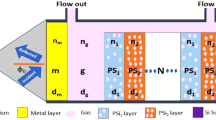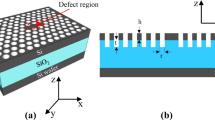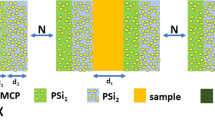Abstract
In this paper, 1D Photonic Crystal structure, consisting of alternate layers of silicon and air, is theoretically studied for gas sensing application. With one of the air layers replaced by a different gas layer, the resulting defect mode can be utilized for sensing a particular gas, from the transmittance curve, calculated by Transfer matrix method. Very small refractive index variation, ∆n = 1.5 × 10−5 and a sensitivity = 979 nm/RIU is found by this sensor.
Access provided by Autonomous University of Puebla. Download conference paper PDF
Similar content being viewed by others
Keywords
1 Introduction
Photonic crystals [1] are periodic dielectric structures which are designed to control the propagation of electromagnetic waves. A semiconductor cannot support electrons of energy lying in the electronic bandgap. Similarly, a photonic crystal cannot support photons lying in the photonic bandgap. Those wavelengths that are not able to pass through the structure is called Photonic bandgap. Three types of photonic crystals structures are studied according to their periodicity, those are one-dimensional-, two-dimensional-, and three-dimensional photonic crystal structures [2].
In 1887, the English physicist Lord Rayleigh [3] investigates a periodic system, he found out that there are special frequency ranges, depending on designed structures, that are forbidden in transmission spectra. In 1987, Yablonovitch [4] and John [5] researched on periodic optical structures with more than one dimension, after that this periodic structure is called photonic crystals.
Gas detection [6] is a major part in many areas such as industry, coal mines, environmental studies or medical application for monitoring or controlling respiratory gases. There are various methods for detection of gases, such as, metal oxide semiconductor for gas sensing, where gases are detected by a redox reaction [7], calorimetric methods, in which catalytic oxidation is mainly used to detect the gases [8]. Here we give some recent work on photonic crystal gas sensors. T. Sünner et al. studied a gas sensor that can detect up to 10−4 RIU refractive index change [9]. An optical-based NO2 gas monitoring system has been studied by Rshmatet et al. [10]. To sense a gas accurately a very small refractive index change of 1.4 × 10−5 is achieved by T. Chen et al. using 1D photonic crystal [11]. A 1D photonic crystal with two defects has been designed to sense novel ozone gas [12]. Two alternating layers of MgF2 and Si with an empty layer in the middle are used to make a sensor which is studied by Bouzidiet et al. [13]. A gas sensor which is studied by S. M. Hamidia et al. where peak frequency measurement is used to sense a gas [14].
In this paper, multilayer stacks of high and low refractive index materials such as Air and Si are chosen to construct 1D photonic crystal gas sensor which is able to sense the presence of a gas, a defect layer, from the change in transmission spectrum, with reference to that of air. Section 2 explains the transfer matrix method [15, 16]. In Sect. 3, the results are discussed and Sect. 4 concludes the result.
2 Theory
2.1 Transmission in the One-Dimensional Photonic Crystal Structure
Figure 1 shows the schematic of 1D photonic crystal. In this structure, alternating periodic layers of silicon and air are used.
Consider that first layer is Si (silicon) which has permittivity ε1, permeability µ1, thickness d1, and refractive index n1 and second layer is air layer which has permittivity ε2 permeability µ2, thickness d2, and refractive index n2.
The transverse component of E and H field inside the Structure from the Maxwell’s equation, for TE polarization is given by
where k = wave number and η = intrinsic impedance are
L is the total number of periodic layers inside the photonic crystal structure.
We can found a relation between the electromagnetic field components EL and HL inside the structure and the electromagnetic field components E1 and H1 in the air in matrix form using the transfer matrix method.
MLis the characteristic matrix of Lth layer
If we consider the angle of incident light (θL) then the characteristic matrix of Lth layer can be written as
δL and γL being the matrix parameters and depending on the incident angle θL of light, the optical constants and the layer thickness are expressed as,
By considering the characteristic matrix of each layer, we can obtain the transmission matrix of the whole structure, where p is the number of periods,
The transmittance t is defined as the ratio of the fluxes of the transmitted wave to the flux of the incident wave.
Here ηi and ηs are the intrinsic impedance of the first and last medium of the structure which is given as,
where
Hence the transmittance T spectrums can be obtained by using the expressions
The sensitivity of this sensor is given by the following expression:
3 Results and Discussion
The analysis using the transfer matrix approach uses four periodic layers of silicon and air on each side of the defect layer.
Different lengths of defect layer are studied to get defect mode within 1.55 μm range, assuming a thickness of Si layer of dSi = 540 nm and thickness of Air layer of dAir = 440 nm, as shown in Fig. 2. For a normal incident of light, defect mode appears within the photonic bandgap, depending on the length of the defect layer. The wavelength of defect mode shifts when cavity length increases from 700 to 900 nm.
The wavelength shifting is linear with the length of the defect layer as shown in Fig. 3. This shift of the wavelength within the photonic bandgap also depends on the thickness of the Si layer (dSi).
When light incident on the structure at an angle other than normal incidence, defect mode shifts in lower wavelength value as shown in Fig. 4. It may also be noted from Fig. 4 that the photonic bandgap increases with increase in incident angle of light which is clear from Fig. 5.
Figure 6a, b shows the transmission characteristics of 1D photonic crystal in the presence of different gases such as Helium (He), Hydrogen (H2), Carbon dioxide (CO2), Methane (CH4), Argon (Ar), Neon (Ne), and Sulfur dioxide (SO2) in the defect layer. The shift in wavelength peak-position is measured taking air as reference. It may be seen from the figure that the peak-position shifts to lower wavelengths for gases having refractive indices less than air, while it shifts to higher wavelengths for gases having higher refractive indices. Thus, the result can be utilized for sensing of different gases.
To study the sensitivity of the device, different thicknesses of silicon and air layer are studied. Curve A, B, C, and D in Fig. 7 denote the corresponding results. Sensitivity, calculated from (16), for those designed structures are 440 nm/RIU, 550 nm/RIU, 654 nm/RIU, and 979 nm/RIU respectively.
4 Conclusion
In this paper, a 1D photonic crystal structure as a gas sensor is studied. The sensor can sense the shift in wavelength of transmission spectra, using Transfer matrix method. The study shows that the defect mode inside the bandgap can shift in between the gap of the photonic bandgap if the length of the Si layer or the length of the defect layer or the angle of incidence of the light on the structure is changed. As a result, this structure is very sensitive to the refractive index change of gases which are present in the dry air. The sensitivity of this sensor will increase if we consider different designs of the device structure.
References
Joannopulos, J.D., Steven, G., Johnson, C.: Photonic Crystals: Molding the Flow of Light. Princeton University Press, Princeton and Oxford (2008)
Steven, G., Johnson, Joannopoulos J.D.: Introduction to Photonic Crystals: Bloch’s Theorem, Band Diagrams, and Gaps (But No Defects). MIT (2003)
Rayleigh, J.W.S.: On waves propagating along the plane surface of an elastic solid. J. Mol. Biol. 7(1), 4–11 (1885)
Yablonovitch, E.: Photonic band-gap structure: the face centered-cubic case employing nonspherical atoms. Phys. Rev. Lett. 67(20), 2295–2298 (1991)
John, S.: Strong localization of photons in certain disordered dielectric superlattices. Phys. Rev. Lett. 58(20), 2486–2489 (1987)
Chraim, F., Erol, Y.B., Pister, K.: Wireless gas leak detection and localization. IEEE Trans. Industr. Inf. 12(2), 768–779 (2016)
Liu, X., Cheng, S., Liu, H.: C: a survey on gas sensing technology. Sensors 12, 9635–9665 (2012)
Nam-Hee Park, T., Akamatsu, T., Itoh, C.: Calorimetric thermoelectric gas sensor for the detection of hydrogen, methane and mixed gases. Sensors 14, 8350–8362 (2014)
Sünner, T., Stichel, T., Kwon, S.-H.: C: photonic crystal cavity based gas sensor. App. Phys. Lett. 92, 261112–261113 (2008)
Rshmat, M., Maulina, W., Rustami, E.: C: performance in real condition of photonic crystal sensor based NO2 gas monitoring system. Atmos. Environ. 79, 480–485 (2013)
Chen, T., Han, Z., Liu, J., Hong, Z.: Terahertz gas sensing based on a simple one-dimensional photonic crystal cavity with high-quality factors. App. Optics. 53, 3454–3458 (2014)
Rahmata, M., Maulinaa, W., Isnaeni, C.: Development of a novel ozone gas sensor based on sol–gel fabricated photonic crystal. Sensors Actuators A Phys. 220, 53–61 (2014)
Bouzidi, A., Bria, D., Akjouj, A., Pennec, Y.: C: A tiny gas-sensor system based on 1D photonic crystal. App. Phys. 48(495102), 1–7 (2015)
Hamidia, S.M., Ramezania, R.: C: hydrogen gas sensor based on long-range surface plasmons in lossy palladium film placed on photonic crystal stack. Opt. Mater. 53, 201–208 (2016)
Barkat, O.: theoretical investigation of transmission and dispersion properties of one dimension photonic crystal. J. Electr. Electron. Eng. 3(2), 12–18 (2015)
Mohamed, M.S., EL-Okr, M.M., Mostafa, M.T.: Transmission and Dispersion Relation of One Dimensional Photonic Crystal Quantum Matter, vol. 5, pp. 1–6 (2016)
Author information
Authors and Affiliations
Corresponding authors
Editor information
Editors and Affiliations
Rights and permissions
Copyright information
© 2019 Springer Nature Singapore Pte Ltd.
About this paper
Cite this paper
Biswas, S., Guin, S., Das, N.R. (2019). Photonic Crystal for Gas Sensing Application. In: Biswas, U., Banerjee, A., Pal, S., Biswas, A., Sarkar, D., Haldar, S. (eds) Advances in Computer, Communication and Control. Lecture Notes in Networks and Systems, vol 41. Springer, Singapore. https://doi.org/10.1007/978-981-13-3122-0_46
Download citation
DOI: https://doi.org/10.1007/978-981-13-3122-0_46
Published:
Publisher Name: Springer, Singapore
Print ISBN: 978-981-13-3121-3
Online ISBN: 978-981-13-3122-0
eBook Packages: EngineeringEngineering (R0)











